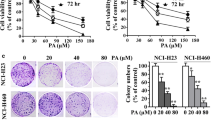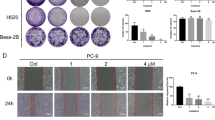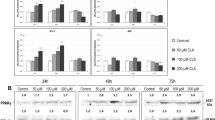Abstract
Celecoxib is a potent nonsteroid anti-inflammatory drug (NSAID) that has demonstrated great promise in cancer chemoprevention and treatment. The goal of this study was to determine the inhibitory effect and mechanism of celecoxib on Lewis lung carcinoma. The effect of celecoxib on viability of Lewis lung carcinoma cells was assessed with methyl thiazolyl tetrazolium (MTT) assay. Apoptosis and the mitochondrial membrane potential were detected by flow cytometric assay. The protein expression of cytosolic phospholipase A2 (cPLA2), cyclooxygenase-2 (COX-2), and peroxisome proliferator-activated receptor gamma (PPARγ) were determined by Western blot analysis. The concentrations of arachidonic acid (AA) and prostaglandin E2 (PGE2) in culture supernatants were measured by the methods of RP-HPLC and PGE2-specific ELISA, respectively. Celecoxib inhibited the proliferation of Lewis lung carcinoma and induced apoptosis in a dose-dependent manner by breakdown of mitochondrial membrane potential. The protein expressions of cPLA2 and PPARγ were upregulated, but COX-2 protein expression was downregulated in the Lewis lung carcinoma cells exposed to celecoxib. The amount of AA was increased and PGE2 was decreased in the culture supernatant, respectively. The ratio of AA to PGE2 was increased in a dose-dependent manner. The major findings in this study are that celecoxib could inhibit the viability of Lewis lung carcinoma cells by interference of the AA pathway and upregulation of PPARγ simultaneously, which are novel and important since the molecular mechanisms of celecoxib underlying the anti-neoplastic effects remain unclear.






Similar content being viewed by others
Explore related subjects
Discover the latest articles and news from researchers in related subjects, suggested using machine learning.References
Matsuyama M, Yoshimura R (2009) Arachidonic acid pathway: a molecular target in human testicular cancer. Mol Med Rep 2:527–531
Matsuyama M, Yoshimura R (2008) The target of arachidonic acid pathway is a new anticancer strategy for human prostate cancer. Biologics 2:725–732
Avis I, Martinez A, Tauler J et al (2005) Inhibitors of the arachidonic acid pathway and peroxisome proliferator-activated receptor ligands have superadditive effects on lung cancer growth inhibition. Cancer Res 65:41–90
Wu T (2006) Cyclooxygenase-2 in hepatocellular carcinoma. Cancer Treat Rev 32:28–44
Yoshimatsu K, Altorki NK, Golijanin D et al (2001) Inducible prostaglandin E synthase is overexpressed in non-small cell lung cancer. Clin Cancer Res 7:2669–2674
Hida T, Yatabe Y, Achiwa H et al (1998) Increased expression of cyclooxygenase 2 occurs frequently in human lung cancers, specifically in adenocarcinomas. Cancer Res 58:3761–3764
Soslow RA, Dannenberg AJ, Rush D et al (2000) COX-2 is expressed in human pulmonary, colonic, and mammary tumors. Cancer 89:2637–2645
Gupta S, Srivastava M, Ahmad N et al (2000) Over-expression of cyclooxygenase-2 in human prostate adenocarcinoma. Prostate 42:73–78
Sano H, Kawahito Y, Wilder RL et al (1995) Expression of cyclooxygenase-1 and -2 in human colorectal cancer. Cancer Res 55:3785–3789
Hwang D, Scollard D, Byrne J et al (1998) Expression of cyclooxygenase-1 and cyclooxygenase-2 in human breast cancer. J Natl Cancer Inst 90:455–460
Fosslien E (2000) Molecular pathology of cyclooxygenase-2 in neoplasia. Ann Clin Lab Sci 30:3–21
Tang X, Sun YJ, Half E et al (2002) Cyclooxygenase-2 overexpression inhibits death receptor 5 expression and confers resistance to tumor necrosis factor-related apoptosis-inducing ligand-induced apoptosis in human colon cancer cells. Cancer Res 62:4903–4908
Nzeako UC, Guicciardi ME, Yoon JH et al (2002) COX-2 inhibits Fas-mediated apoptosis in cholangiocarcinoma cells. Hepatology 35:552–559
Chen WS, Wei SJ, Liu JM et al (2001) Tumor invasiveness and liver metastasis of colon cancer cells correlated with cyclooxygenase-2 (COX-2) expression and inhibited by a COX-2-selective inhibitor, etodolac. Int J Cancer 91:894–899
Tomozawa S, Tsuno NH, Sunami E et al (2000) Cyclooxygenase-2 overexpression correlates with tumour recurrence, especially haematogenous metastasis, of colorectal cancer. Br J Cancer 83:324–328
Leahy KM, Koki AT, Masferrer JL (2000) Role of cyclooxygenases in angiogenesis. Curr Med Chem 7:1163–1170
Nakanishi M, Rosenberg DW (2006) Roles of cPLA2alpha and arachidonic acid in cancer. Biochim Biophys Acta 1761:1335–1343
Li B, Gu L, Zhang H, Huang J et al (2007) Up-regulation of cPLA(2) gene expression in astrocytes by all three conventional anti-bipolar drugs is drug-specific and enzyme-specific. Psychopharmacology (Berl) 194:333–345
Sertznig P, Seifert M, Tilgen W et al (2007) Present concepts and future outlook: function of peroxisome proliferator-activated receptors (PPARs) for pathogenesis, progression, and therapy of cancer. J Cell Physiol 212:1–12
Keshamouni VG, Han S, Roman J (2007) Peroxisome proliferator-activated receptors in lung cancer. PPAR Res 2007:90289
Wang T, Xu J, Yu X et al (2006) Peroxisome proliferator-activated receptor gamma in malignant diseases. Crit Rev Oncol Hematol 58:1–14
Han S, Roman J (2007) Peroxisome proliferator-activated receptor gamma: a novel target for cancer therapeutics? Anticancer Drugs 18:237–244
Tian L, Zhou J, Casimiro MC et al (2009) Activating peroxisome proliferator-activated receptor gamma mutant promotes tumor growth in vivo by enhancing angiogenesis. Cancer Res 69:9236–9244
Evans NP, Misyak SA, Schmelz EM et al (2010) Conjugated linoleic acid ameliorates inflammation-induced colorectal cancer in mice through activation of PPARgamma. J Nutr 140:515–521
Masferrer JL, Leahy KM, Koki AT et al (2000) Antiangiogenic and antitumor activities of cyclooxygenase-2 inhibitors. Cancer Res 60:1306–1311
Blumenthal RD, Waskewich C, Goldenberg DM et al (2001) Chronotherapy and chronotoxicity of the cyclooxygenase-2 inhibitor, celecoxib, in athymic mice bearing human breast cancer xenografts. Clin Cancer Res 7:3178–3185
Williams CS, Watson AJ, Sheng H et al (2000) Celecoxib prevents tumor growth in vivo without toxicity to normal gut: lack of correlation between in vitro and in vivo models. Cancer Res 60:6045–6051
Liu XH (2000) Inhibition of cyclooxgenase-2 suppresses angiogenesis and the growth of prostate cancer invivo. J Urol 164:820–825
Waskewich C, Blumenthal RD, Li H et al (2002) Celecoxib exhibits the greatest potency amongst cyclooxygenase (COX) inhibitors for growth inhibition of COX-2-negative hematopoietic and epithelial cell lines. Cancer Res 62:2029–2033
Blaine SA, Wick M, Dessev C et al (2001) Induction of cPLA2 in lung epithelial cells and non-small cell lung cancer is mediated by Sp1 and c-Jun. J Biol Chem 276:42737–44243
Shaik MS, Chatterjee A, Jackson T et al (2006) Enhancement of antitumor activity of docetaxel by celecoxib in lung tumors. Int J Cancer 118:396–404
Scorrano L, Penzo D, Petronilli V et al (2001) Arachidonic acid causes cell death through the mitochondrial permeability transition. Implications for tumor necrosis factor-alpha apoptotic signaling. J Biol Chem 276:12035–12040
Theocharis S, Kanelli H, Politi E et al (2002) Expression of peroxisome proliferator activated receptor-gamma in non-small cell lung carcinoma: correlation with histological type and grade. Lung Cancer 36:249–255
Han S, Roman J (2006) Rosiglitazone suppresses human lung carcinoma cell growth through PPARgamma-dependent and PPARgamma-independent signal pathways. Mol Cancer Ther 5:430–437
Hazra S, Batra RK, Tai HH et al (2007) Pioglitazone and rosiglitazone decrease prostaglandin E2 in non-small-cell lung cancer cells by up-regulating 15-hydroxyprostaglandin dehydrogenase. Mol Pharmacol 71:1715–1720
Krey G, Braissant O, L’Horset F et al (1997) Fatty acids, eicosanoids, and hypolipidemic agents identified as ligands of peroxisome proliferator-activated receptors by coactivator-dependent receptor ligand assay. Mol Endocrinol 11:779–791
Lehmann JM, Lenhard JM, Oliver BB et al (1997) Peroxisome proliferator-activated receptors alpha and gamma are activated by indomethacin and other non-steroidal anti-inflammatory drugs. J Biol Chem 272:3406–3410
Acknowledgments
This study was supported by a grant from the development plan project of Jilin provincial science and technology department of China (200705163).
Author information
Authors and Affiliations
Corresponding authors
Additional information
Ming Zhang and Zhi-Gang Xu contribute equally to this work.
Rights and permissions
About this article
Cite this article
Zhang, M., Xu, ZG., Shi, Z. et al. Inhibitory effect of celecoxib in lung carcinoma by regulation of cyclooxygenase-2/cytosolic phospholipase A2 and peroxisome proliferator-activated receptor gamma. Mol Cell Biochem 355, 233–240 (2011). https://doi.org/10.1007/s11010-011-0859-5
Received:
Accepted:
Published:
Issue Date:
DOI: https://doi.org/10.1007/s11010-011-0859-5
Keywords
Profiles
- Dan Shao View author profile




